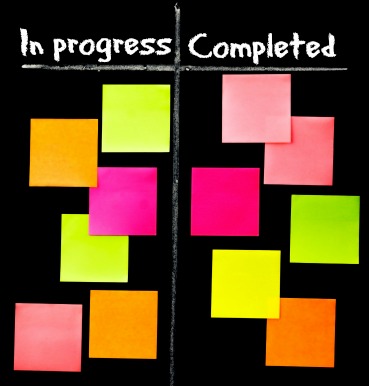Project Management for Beginners
It’s a term that can intimidate and put off many professionals. The thought of “project management” leads many people to envision old businessmen in suits around a conference room table with charts and graphs, arguing about things like “deliverables” and “scope creep”. Ew.
Truth is, every business owner, every manager, participates in project management whether that’s what they call it or not.

It’s the key to any successful business: planning ahead to ensure things are completed on time and within budget. Having a basic understanding of basic project management methods will help you become a well-rounded business owner and professional.
Regardless of the method you use, there are some key elements that one must follow when planning a project.
Let’s pause. The word “project” deserves a definition. It can mean anything from a case study, to a single blog article, to a full-blown 1,000-page novel.
Goals & Requirements
First thing’s first: write down what you expect to see as a finished product. What, in your mind or in your understanding, would classify the project as “successful”. If it’s a particularly large project, you’ll likely have many goals… in which case you’ll want to list them in order of priority.
Keep these goals handy and when you’re working on your project, continue to refer back to them. It’s amazing how easily human beings get side-tracked and focus on details that really don’t matter in the end. Before you start a task, ask yourself if that task will help you reach the end goal(s). If the answer is “no”, then your time is likely best spent elsewhere.
On top of your overarching goals and objectives for the project, are there any requirements you must meet? This will probably include elements like your budget, target audience, language, and – if you’re working with a client – any requirements from your clients (colors, themes, etc.)
You’ll also want to establish who your stakeholder(s) is or are. The stakeholder is whoever has the “final say” on the project. This person will be the one to help you establish all your requirements for the project, and the one who will decide – at the end of the day – if the end product meets those requirements.
Note: This is arguably the most important part of project management. Take your time and work with the stakeholder(s) to make sure they agree with your interpretation of the requirements for the project. If you’re the stakeholder, then you’re in great company! If your stakeholder is a client, this is where a good client interview (probably several) will be key.

Breaking Down Individual Tasks
Here’s where the nitty-gritty comes in. An effective project manager (yes, that’s you!) will work very hard to list every, single, task required of a project in order for it to see completion.
The devil’s in the details!
You’ll want to get quite granular in your task descriptions. The best way to achieve this, is to work backwards.
Start with your end goal. Let’s say the project is the launch of a brand new online store. Next, list the 5 or 6 main tasks needed to achieve this launch. Let’s say the launch has 6 major tasks that need to be completed before it’ll be ready for publishing:
- Wireframe
- Text
- Images
- Shopping Cart
- Design & Layout
- Testing & Launch
Next, break down each of THOSE tasks into the 5-10 sub-tasks required.
For example, the task “text” would be further broken down into six subtasks, for each webpage:
- Research
- First Draft
- Review
- Peer Review
- Proofread
- Final copy
Depending on the project, there could be 3 or 4 levels of sub tasks. Your task list will probably end up looking like a big tree!
Planning for Time
Almost every single project will have a firm deadline. This could be the date of an event, a publication date, a meeting or conference date. Make sure you know what date this is!
Now, are there any secondary due dates that are set-in-stone? Do you have client meetings scheduled? Maybe it’s a first draft for an editor? Again, make sure you have ALL these dates written down.
Next, go back to your task list as discussed above, and try to estimate the amount of time you think it’ll take to complete each of these tasks. You can either go at a high level and just estimate in days, or go much more specific and estimate in hours or even minutes!
Personally, I find planning tasks in terms of “days” works pretty well, drilling down to half-days or quarter-days for very small tasks.

Choosing your Method
The project management method you use will depend on a few factors.
The first is how many people you have working on the same project. If you’re a one-man (or woman) show, then likely the method you choose doesn’t really matter since only one task will be completed at a time. If you have multiple people working on the same project, you’ll want to use a method that allows each person to work effectively to help you reach your end goals!
You’ll also want to consider the skillset of those working on the project. Do they all have identical skills, or do you have a few specialists who will work on only select tasks?
Next, look at your task list. Are all the tasks dependent on one another? Does task A need to be completed before Task B can start, and so on? In most cases, you’ll likely find that some tasks need to be done sequentially while some can be done independently.
If we return to our online store launch example, for instance, it’s definitely a good idea to get the text finalized before you choose the images for your site. However, while these tasks are being completed, you can also have a developer work on the shopping cart.
With those two elements in mind, consider which of the following methods work best for you:
Classic Waterfall Method
This linear approach is also considered “classic project management” by some industry veterans.
True to its name, the waterfall method works wonderfully for projects where one task depends on the previous one in order to complete the project. Once everything is complete and absolutely perfect, the project is complete.
It’s very simple: Complete task A, then move on to task B, and so on. Assign due dates to individual tasks, working backward from the final project due date and based on your time estimates for each task.

Using the online store example again, let’s say it’s due next Friday March 27th. I’ve established that the final two tasks are layout (estimated 2 days to complete), followed by testing (estimated 1 day to complete).
Giving myself a bit of a buffer, the due date for the “testing” task (with all its sub-tasks) will be Thursday the 26th. Working backward from there, and knowing the testing task will take me a day, the “layout” task therefore cannot be due any later than Wednesday the 25th.
The great news about the waterfall project management method is that it’s very MS-Excel friendly. You can easily download about a hundred different templates for Gantt charts that will help you plot all your tasks and figure out their due dates!
Agile Method
Agile project management has increased in popularity over the past 10 years. The word “agile” is taken quite literally… meaning, flexible!
In an agile method, you’ll pair tasks that must be completed sequentially with tasks that can be completed at any time. The goal of agile is to complete (meaning, launch, publish, release) portions of the project while continuing to work on other tasks.
For instance, with the online store launch, an agile approach to the project would see us publishing each web page as it’s completed, while we’re still working on other pieces of the site.
This type of process is most useful when your project is a specific “product” and not a “service”. For instance, an agile approach to organizing a fashion show wouldn’t be very practical!
By contrast, a home renovation project might be exactly the perfect situation for an agile approach. In this case, you might complete the living room first, then move on to the kitchen, then the bathroom… this might be more practical for the homeowners than gutting the entire house and working on all the plumbing, then all the electricity, then all the painting, and so on.
While both agile and waterfall methods will have the same completion date (or close to it), the agile method will allow you to “deliver” parts of your project in increments.
Where the waterfall method will rely on a Gantt Chart, the agile method is best organized on a board where you can write tasks on cards or post-its, and move them from a “to do” column to a “doing” column and finally to a “done” column.
Pro Tip: If you like the idea of this board approach, check out Trello – an online software that quickly allows you to organize a project by individual task.

Once it’s all done
Something not many people bother with – though it’s highly beneficial – is to take some time once your project is complete to look back and analyze how the entire project was done, from top to bottom. Are there any elements that could have gone better? Did you encounter any unexpected delays? And on the flip side, did anything go particularly well? Answering these questions will allow you to plan your next project more effectively.
Now get to it!
If you’re the type of person who has the “it’ll happen when it happens” philosophy, I challenge you to try this more practical approach to your next project. I can’t wait to hear how it goes!





